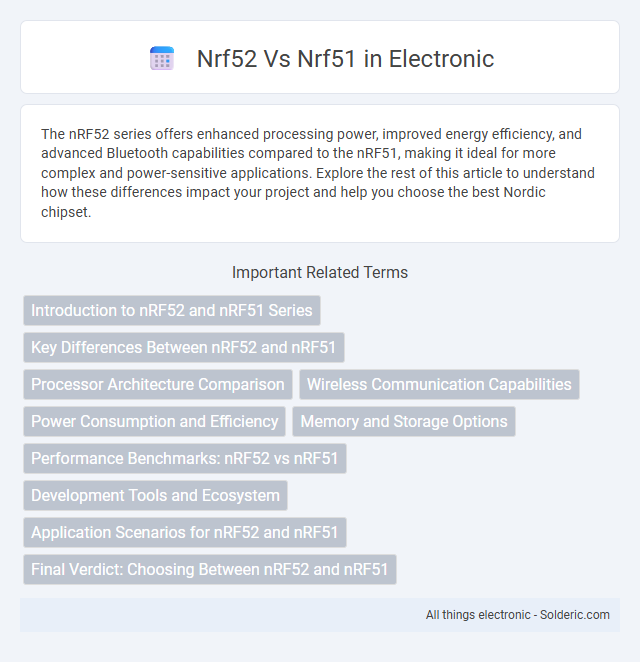The nRF52 series offers enhanced processing power, improved energy efficiency, and advanced Bluetooth capabilities compared to the nRF51, making it ideal for more complex and power-sensitive applications. Explore the rest of this article to understand how these differences impact your project and help you choose the best Nordic chipset.
Comparison Table
| Feature | nRF52 Series | nRF51 Series |
|---|---|---|
| Processor | ARM Cortex-M4F, 64 MHz | ARM Cortex-M0, 16 MHz |
| Bluetooth Version | Bluetooth 5.2, Bluetooth 5, BLE | Bluetooth 4.2, Bluetooth 4.1, BLE |
| Memory (Flash/RAM) | Up to 1MB Flash / 256KB RAM | Up to 256KB Flash / 32KB RAM |
| Power Consumption | Lower power, efficient sleep modes | Moderate power, basic sleep modes |
| Peripherals | Advanced: ADC, NFC, PWM, SPI, I2C, UART | Basic: ADC, PWM, SPI, I2C, UART |
| Security | ARM TrustZone, AES, Crypto & RNG | AES, Basic security features |
| Use Case | Advanced IoT, wearables, complex applications | Basic IoT, simple peripherals |
Introduction to nRF52 and nRF51 Series
The nRF52 and nRF51 series are Bluetooth low energy System on Chips (SoCs) developed by Nordic Semiconductor, widely used in wearable technology and IoT applications. The nRF52 series offers enhanced CPU performance, improved power efficiency, and expanded memory compared to the nRF51 series, making it suitable for more complex applications demanding higher processing capabilities. Your choice between nRF51 and nRF52 will depend on the specific application requirements, such as power consumption, processing power, and memory constraints.
Key Differences Between nRF52 and nRF51
The nRF52 series offers significant advancements over the nRF51, including a more powerful 32-bit ARM Cortex-M4 processor with floating-point unit compared to the 32-bit ARM Cortex-M0 in nRF51. It features enhanced Bluetooth 5 support, increased memory size up to 512 KB flash and 64 KB RAM, and improved power efficiency for extended battery life. Advanced peripherals such as a high-speed SPI, increased number of GPIOs, and better analog capabilities distinguish the nRF52 for demanding IoT and wireless applications.
Processor Architecture Comparison
The nRF52 series features an ARM Cortex-M4F processor, offering enhanced processing power and efficient floating-point calculations compared to the nRF51 series, which uses an ARM Cortex-M0 processor. The Cortex-M4F architecture in nRF52 enables improved performance for complex algorithms and signal processing tasks, while maintaining low power consumption. This architectural upgrade makes the nRF52 ideal for advanced IoT applications requiring higher computational capabilities.
Wireless Communication Capabilities
The nRF52 series offers advanced wireless communication capabilities with support for Bluetooth 5, providing increased range, speed, and broadcasting capacity compared to the nRF51 series, which primarily supports Bluetooth 4.2. The nRF52 features enhanced radio sensitivity and power efficiency, enabling more reliable connections and lower energy consumption in IoT applications. Its improved protocol stack and support for multiple wireless standards such as ANT and proprietary 2.4 GHz communication also deliver greater versatility over the nRF51.
Power Consumption and Efficiency
The nRF52 series features significantly lower power consumption compared to the nRF51, with an optimized ARM Cortex-M4 processor that enhances efficiency during both active and sleep modes. Its advanced power management system supports ultra-low power modes, reducing current drain to as low as 1.5 uA in System ON sleep mode and minimizing energy use in Bluetooth Low Energy (BLE) operations. The nRF52 also benefits from a higher processing capability per milliwatt, making it ideal for battery-operated IoT devices requiring extended lifetime and reliable performance.
Memory and Storage Options
The nRF52 series offers significantly increased memory compared to the nRF51, featuring up to 512 KB Flash and 64 KB RAM, whereas the nRF51 typically provides up to 256 KB Flash and 32 KB RAM. This expanded memory in nRF52 supports more complex firmware and larger application codebases, enhancing device performance and functionality. Both series utilize ARM Cortex-M processor cores, but the nRF52's improved memory architecture facilitates more efficient storage management and faster data access for advanced IoT applications.
Performance Benchmarks: nRF52 vs nRF51
The nRF52 series offers significantly improved performance benchmarks compared to the nRF51, featuring a 64 MHz ARM Cortex-M4F processor with DSP and floating-point capabilities versus the 16 MHz ARM Cortex-M0 in the nRF51. This results in up to 3x faster processing speeds and enhanced energy efficiency, enabling more complex applications and extended battery life. Additionally, the nRF52 supports advanced features like improved radio performance and encryption, making it ideal for modern IoT devices requiring higher throughput and security.
Development Tools and Ecosystem
The nRF52 series offers a more advanced development ecosystem with improved support for SEGGER Embedded Studio and enhanced debugging features compared to the nRF51 series, streamlining your firmware development process. Nordic's SDK for nRF52 introduces richer libraries and middleware, including Bluetooth 5 and newer protocols not fully supported on nRF51. This expanded ecosystem accelerates prototyping and reduces time-to-market by offering robust examples and community support tailored for nRF52 devices.
Application Scenarios for nRF52 and nRF51
The nRF52 series excels in complex applications such as advanced wearables, IoT devices, and Bluetooth 5.0 peripherals due to its improved processing power, enhanced power efficiency, and extended range capabilities. The nRF51 is better suited for simpler, cost-sensitive products like basic fitness trackers and low-power sensors where Bluetooth 4.2 support and lower computational needs suffice. Your choice should align with performance demands and power consumption requirements specific to your application scenario.
Final Verdict: Choosing Between nRF52 and nRF51
The nRF52 series offers significant improvements over the nRF51, including enhanced processing power with a 64 MHz ARM Cortex-M4 CPU, more memory, and advanced Bluetooth 5 capabilities, making it ideal for demanding applications. Your choice should depend on project requirements: opt for nRF51 for simpler, low-power tasks or the nRF52 if you need higher performance, extended range, and improved security features. Both series support Bluetooth Low Energy, but the nRF52 delivers better efficiency and future-proofing for long-term deployments.
nrf52 vs nrf51 Infographic

 solderic.com
solderic.com